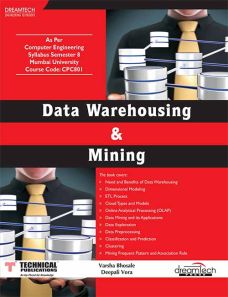Data Warehousing & Mining
ISBN: 9789351199168
388 pages
For more information write to us at: acadmktg@wiley.com

Description
This book, Data Warehousing and Mining, is a one-time reference that covers all aspects of data warehousing and mining in an easy-to-understand manner. It covers a variety of topics, such as data warehousing and its benefits; architecture of data warehouse; data mart, data warehousing design strategies, dimensional modeling and features of a good dimensional model; different types of schemas such as star schema, snowflake schema; fact tables and dimension tables; concept of primary key, surrogate keys and foreign keys; ETL process; different types of data extraction such as immediate data extraction and deferred data extraction.
Chapter 1: Introduction to Data Warehousing
1.1 The Need for Data Warehousing
1.2 Operational vs. Decisional Support System
1.3 Data Warehouse Defined
1.4 Role of Metadata
1.5 Data Warehouse Architecture
1.6 Different Types of Architecture of Data Warehouse
1.7 Data Warehouse and Data Mart
1.8 Data Warehousing Design Strategies
Chapter 2: Dimensional Modeling
2.1 Data Warehouse Modeling versus Operational Modeling
2.2 Dimensional Model versus Entity-Relationship Model
2.3 Features of a Good Dimensional Model
2.4 The Star Schema
2.5 The Snowflake Schema
2.6 Introducing the Fact Table
2.7 Introducing the Dimension Table
2.8 The Factless Fact Table
2.9 Updates to Dimension Tables
2.10 Slowly Changing Dimensions
2.11 Large Dimension Tables
2.12 Rapidly Changing or Large Slowly Changing Dimensions
2.13 Junk Dimensions
2.14 Keys in the Data Warehouse Schema
2.15 Aggregate Table
2.16 Fact Constellation Schema or Family of Stars
Chapter 3: ETL Process
3.1 Overview of ETL Process
3.2 Data Extraction
3.3 Data Transformation: Tasks Involved in Data Transformation
3.4 Data Loading: Techniques of Data Loading
3.5 Loading the Fact Tables
3.6 Loading the Dimension Tables
Chapter 4: Online Analytical Processing (OLAP)
4.1 Need for Online Analytical Processing
4.2 OLTP vs. OLAP
4.3 OLAP and Multidimensional Analysis
4.4 Hypercubes
4.5 OLAP Operations in Multidimensional Data Model
4.6 OLAP Models
4.7 Popular OLAP tools
Chapter 5: Introduction to Data Mining
5.1 What is Data Mining?
5.2 Knowledge Discovery in Database (KDD)
5.3 What Type of Data can be Mined?
5.4 Concepts Related to Data Mining
5.5 Data Mining Techniques
5.6 Applications of Data Mining
5.7 Issues in Data Mining
Chapter 6: Data Exploration
6.1 Exploring Data
6.2 Types of Data Attributes
6.3 Statistical Description of Data
6.4 Data Visualization
6.5 Measuring Similarity and Dissimilarity in Data
Chapter 7: Data Preprocessing
7.1 Why Preprocessing?
7.2 Data Cleaning
7.3 Data Integration
7.4 Data Reduction
7.5 Data Transformation
7.6 Data Discretization and Concept Hierarchy Generation
Chapter 8: Classification and Prediction
8.1 Basic Concepts
8.2 Classification Methods
8.3 Bayesian Classification
8.4 Classification by Artificial Neural Networks
8.5 Lazy Learners
8.6 Associative Classification
8.7 Other Classification Methods
8.8 Prediction
8.9 Model Evaluation and Selection
8.10 Combining Classifiers (Ensemble Methods)
Chapter 9: Clustering and Trends in Data Mining
9.1 Cluster Analysis
9.2 Types of Data in Clustering
9.3 Categorization of Major Clustering Methods
9.4 Partitioning Methods
9.5 Hierarchical Methods
9.6 Density-Based Clustering
Chapter 10: Frequent Pattern Mining
10.1 Market Basket Analysis
10.2 Efficient and Scalable Frequent Pattern Mining Methods
10.3 Multilevel and Multidimensional Association Rules
10.4 Association Rule Mining to Correlation Analysis
10.5 Constraint-Based Association Mining
Summary
Review Exercise
Multiple Choice Questions
Descriptive Questions
Index

